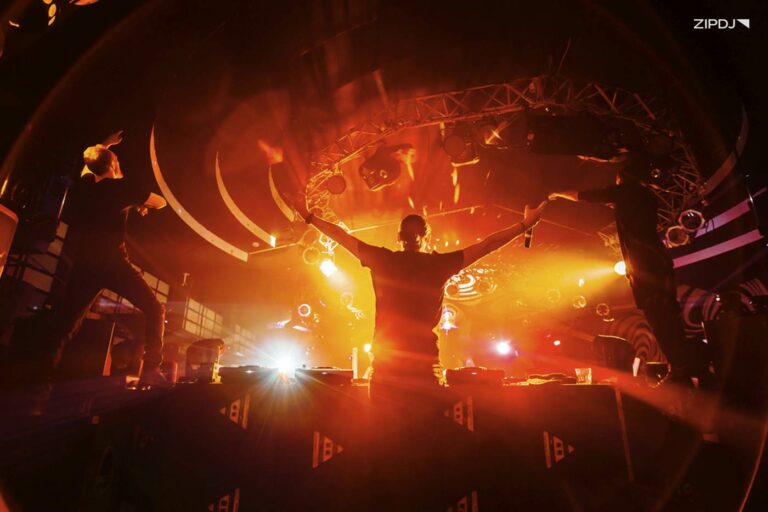AI Lighting: How Artificial Intelligence Is The Future of DJ Lighting

The rapidly evolving pace of technological development is opening up new and exciting opportunities for DJs to create vibrant and engaging visuals.
With artificial intelligence impacting everything from playlist creation to lighting, there are new solutions available for DJs to enhance their visual flair.
Continue reading to discover how AI lighting is evolving to deliver powerful new creative opportunities that DJs can incorporate into their live sets.

AI Lighting: How Artificial Intelligence Is The Future of DJ Lighting
Whether you’re a mobile DJ performing at private events or a professional club DJ, lighting can be a powerful tool for creating immersive experiences.
With traditional LED lighting undergoing a radical overhaul thanks to artificial intelligence, the scope for visually creative DJ sets is set to expand.
So, to help you invest in the right technology, here’s everything you need to know about AI lighting and the future of DJing in 2025:
Traditional DJ Lighting
Traditional DJ lighting comes in a variety of styles, from old-school disco lights and strobes to customizable LED lighting with millions of colors.
Available in a wide range of budgets, these lights are suitable for use with beginner DJ equipment or in the best nightclubs around the world.
While this traditional technology has evolved to improve efficiency and deliver versatile sequencing, it still presents limitations that need to be considered.
Let’s examine some of the limitations and challenges DJs face with traditional lighting, which artificial intelligence looks set to overcome.
Limitations & Challenges
Whatever your style of DJing, you should be aware of basic lighting aesthetics and how they can enhance the audience’s experience.
Traditional DJ lighting includes many options for creating lighting displays through programmed sequences and patterns.
However, such patterns and sequences aren’t adaptive, and if you want to change them, you’ll need to interface with the lighting hardware manually.
Traditional DJ lights are also restricted by their placement and won’t respond to changes in the environment or other real-time factors.
They can also be prone to overheating, making it difficult to track down the source of a problem when using complex lighting rigs.
AI DJ Lighting: A New Era
The advent of artificial intelligence is already having a notable impact on DJ lighting and how it can be used for a variety of important processes.
On a technical level, AI lighting can help to manage lighting systems and improve efficiency, safety, and other vital aspects of the process.
AI lighting is also opening up new creative methods through adaptive performance that responds to changes in the environment or music.
This is especially true for DJs already accustomed to incorporating images and animations into their sets through collaboration with designers.
An example of this can be seen in the use of AI photography and music for Hayden Martin’s Boiler Room performances, which utilize powerful neural networks.
While the technology is still in its infancy, there is a growing selection of hardware and software geared toward DJing industry professionals.
Why Switch To AI For DJ Lighting
With artificial intelligence in LED lighting continuing to evolve, its role in the entertainment sector is set to expand over the following years.
As such, DJs who adopt this new technology early on will be at a distinct advantage over their competitors when delivering visually striking sets.
Artificial intelligence lighting has already made considerable headway in the hospitality industry and created unique atmospheres in high-end restaurants.
The same principles applied in these settings have broad applications, from using color changes to alter mood to automatically reducing energy consumption.
Autonomous lighting solutions such as MaestroDMX are paving the way for professionals to deliver truly intelligent lighting based on your music.
It’s a revolutionary technology for all types of DJs because it allows them to coordinate light shows across a multitude of light fixtures.
Operated via a mobile app, it can build lighting cues based on the set’s tracks while responding to the audience in real-time.
With many more companies investing in research and development for artificial intelligence lighting systems, it pays to make the switch early.
1. Effortless Light Show Creation
Artificial intelligence has opened up many avenues for streamlining various workflows to minimize the amount of time and effort required.
This is true for AI lighting, which delivers a fully optimized light show without requiring lengthy programming and preparation.
Using this DJ technology to react to the environment and music can create adaptive light shows that match the tone of the event.
By tailoring it to the venue, AI lighting can accentuate the room’s features, add warmth to specific areas, and respond to occupancy levels.
2. Dynamic & Responsive To Music
Just as artificial intelligence lighting can respond to the environment, it can also be linked to music for dynamic and responsive performance.
This begins with a full analysis of playlists to allow for dynamic lighting changes based on tempo, key, tone, and other musical qualities.
For example, DJs playing fast-paced techno can incorporate rapid changes to strobes and other lighting that keep audience energy levels high.
On the other hand, wedding and mobile DJs can create warmer-toned lighting displays that capture the spirit of their event with visual style.
Thanks to its real-time adaptive systems, AI light systems can react on the fly, meaning DJs don’t have to stick to their sets when considering visuals.
With the future of music bringing new and exciting music genres, adaptive and dynamic AI lighting is a fitting companion to DJ sets.
3. Reads The Crowd & Mood
Another huge advantage that AI lighting promises for DJs is the tools it offers for instantly reacting to the crowd’s behavior.
One of the most important aspects of DJ performances is reading the crowd and responding to their behavior by dropping an impressive track.
With AI lighting, DJs can take this reactive process into the visual sphere, instantly controlling their lights using hardware controllers.
AI. Lightshow is one AI tool leading the way in this field, using onboard capacitive touch sensor buttons for dynamic displays.
These tools combine with sound-activated lighting options that analyze a track’s drop, build-up, breakdown, and other elements.
By bringing all of these tools together, DJs can augment their track selection in response to the crowd with instantaneous lighting updates.

4. Enhanced Audience Engagement
Thanks to AI technology, DJs can take a much more nuanced approach to lighting displays and enhance their audience engagement.
For club DJs, this means lowering lighting levels on the fly to build tension and create a sense of dramatic mood and build-up.
For corporate, wedding, and mobile DJs, AI lighting has great potential for placing a spotlight on speaking guests and other activities.
In short, it can be used in a variety of ways to improve the art of DJing and tailor the environment to the audience’s reactions.
5. Customizable Lighting Profiles
One of the biggest draws to AI technology is its ability to progressively learn and adapt based on the available data and information.
This process impacts AI lighting in a variety of ways, with the tools building on past activities to create more nuanced behaviors in the future.
As DJs continue to incorporate AI in their lighting rigs, the potential for customizable profiles and impressive lighting displays will continue to expand.
With no programming knowledge required, DJs can deliver flawless light shows for their clients by creating customized display profiles.
6. Voice & Gesture Control Options
The latest AI lighting systems incorporate the familiar selection of touchscreen displays, sliders, and knobs to use when controlling displays.
At the same time, they’re also making headway in fully voice-controlled systems that allow for a completely hands-off approach to functionality.
Likewise, systems such as AI Lightshow from DMX Lighting are taking the technology to the next level with new sound activation systems.
This will allow DJs to make rapid alterations to lighting displays without having to take their attention away from mixing their DJ sets.
7. Seamless Integration With Existing Setups
Integrating systems can be complex, whether you’re working on a new mobile DJ setup or a professional rig for a nightclub.
AI lighting uses distinct controllers for operation, and it can be fully integrated into an existing DJ setup with relative ease.
Such controllers are compact and lightweight, take up minimal space in a DJ booth, and don’t require a radical overhaul of a setup.
They can also work with existing lighting rigs, so you don’t have to invest thousands of dollars in an all-new light system to use them.
Platforms such as MaestroDMX have been designed with full support for moving head and gobo light systems that are widely used in venues.
Its designers have also removed the requirement for MIDI sync and other technological headaches to streamline integration processes further.
8. Personalized Lighting Experiences
Another potential advantage of AI lighting is the ability to use the customization process to create truly personalized lighting experiences.
Many DJs use their own logos and other branding elements to build their reputations with fans, and AI can greatly improve this process.
In addition to creating unique light displays, AI tools can be used with projections and other large-screen footage to personalize them further.
Users can add a photo to include in the visual display, such as when performing a DJ set at a birthday party or anniversary.
These assets can be controlled via the AI tool’s smartphone app, which adapts the image to match the lighting for a consistent aesthetic.
The future of music is increasingly connected to the online world, and AI lighting will bridge the gap between traditional lights and virtual avatars.
9. Collaborative AI & Human Control
Anyone who has used ChatGPT understands the symbiotic relationship between artificial intelligence and the quality of human input.
This relationship is a vital element of AI-controlled lighting and how the technology can learn through the user’s input.
Indeed, human input is an intrinsic element of AI’s development, and the more feedback the system receives, the better the end results.
This means that AI lighting will continue to improve as more DJs use these systems to enhance the lighting and visuals in their sets.
It will also evolve through the application of human oversight, creating new and more powerful iterations with improved responsiveness.
Through a process of simulation, learning, and self-correction, AI lighting systems will inevitably go from strength to strength over the coming years.
10. Unlocks Creativity For All DJs
If there’s an overarching message behind AI lighting’s power and potential, it’s the technology’s ability to unleash creative potential fully.
While the debate still rages over using AI for music creation, no such limitations and barriers exist in the world of AI lighting.
DJs familiar with standard lighting and how it can be used to dramatic effect can significantly expand their palettes with AI lights.
It offers impressive potential for one-of-a-kind lighting displays for special events and an interactive process for continual improvement.
Likewise, DJs working in the virtual sphere, whether VR DJing or streaming on Twitch, can also incorporate AI technology into visual displays.
It also has the potential to become fully integrated with video DJing tools, combining video footage, animation, and lighting.
AI lighting technology features autonomous control of everything from colors to movement and dimming, allowing DJs to focus on their sets.
Whereas lighting was once considered a necessary evil for DJs, new AI technology is already reshaping the industry in new and exciting ways.
Summary
Creating a visually impressive experience for your audience is a great way to complement your choice of music with a full-sensory performance.
By implementing the best practices and ideas featured in this guide, you can embrace the power of artificial intelligence and stand out from the competition.
As the technology evolves, new and more powerful software will emerge that offers in-depth tools for creatively manipulating light sources.
Not a member ?
Join Today for Unlimited Music Downloads. Visit zipdj.com for more information.



